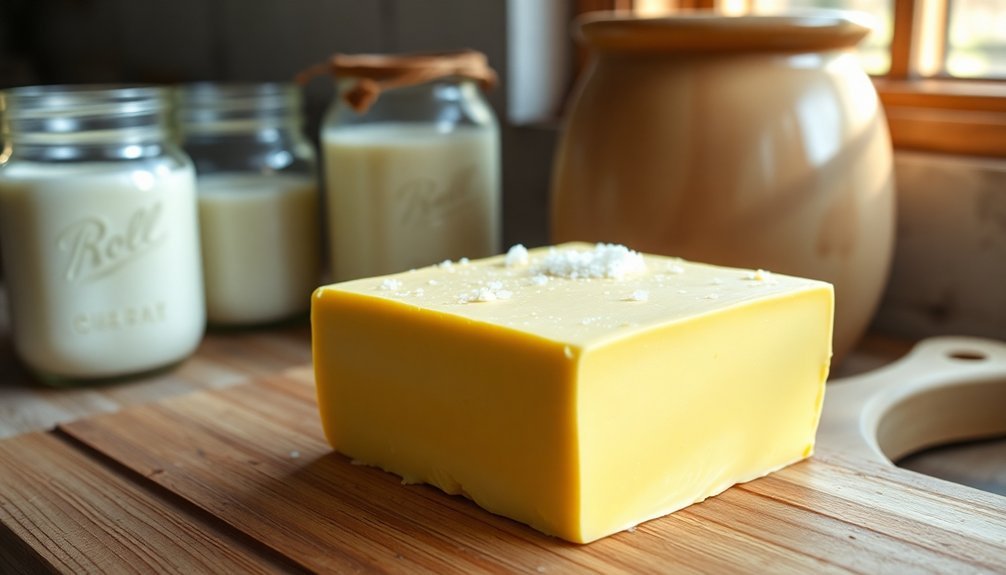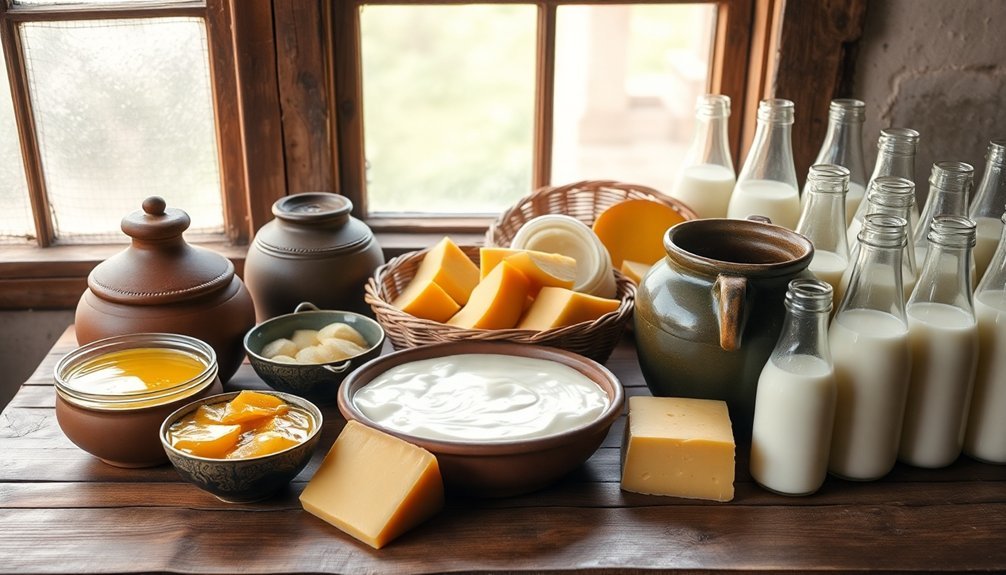Real orange marmalade captures a perfect balance of bitter and sweet that you won't find in mass-produced versions. It's made with carefully selected citrus fruits, particularly Seville oranges known for their intense flavor and high pectin content. You'll taste the difference in its complex layers – from the tender strips of peel to the bright, concentrated fruit essence. The natural pectin from the fruit's pith and peel creates that signature glossy texture without artificial additives. While it's delicious on morning toast, proper marmalade's versatility extends far beyond breakfast, opening up a world of culinary possibilities.
The Art of Citrus Selection

Don't limit yourself to traditional oranges, though. You can create exceptional marmalades using Meyer lemons, Bearss limes, bergamots, or yuzus.
Each brings its own distinct flavor profile to the table. Fresh fruit picking ensures the highest quality marmalade since citrus skins toughen during storage. Remember that whatever variety you choose, the fruit's natural pectin content – found in the pips, juice, and pith – will be essential for achieving that perfect set.
From Peel to Preserve
You'll want to start the marmalade-making process by carefully zesting your oranges into precise, uniform strips that include the flavorful outer peel and just enough of the white membrane for natural pectin.
The key to perfect peel preparation lies in achieving consistent 1/8-inch strips and removing any excess pith that could make your marmalade too bitter. The one month shelf life of homemade marmalade makes proper preparation even more crucial for optimal enjoyment.
Every strip of peel counts in creating that signature bitter-sweet balance, so take your time to slice methodically and evenly, ensuring each piece will contribute to the ideal texture and taste of your finished preserve.
The Art of Zesting
Before diving into marmalade-making, mastering the art of zesting citrus peel becomes essential for achieving that perfect balance of flavor and texture. You'll need to choose your zesting method based on your recipe's requirements and your comfort level with different tools.
| Tool | Technique | Best For |
|---|---|---|
| Microplane | Drag orange at angle | Fine, delicate zest |
| Box Grater | Use finest holes | Medium-fine zest |
| Vegetable Peeler | Long strips | Marmalade strips |
| Paring Knife | Top-to-bottom strips | Wide peel cuts |
| Hand Zester | Short, controlled strokes | Traditional style |
When you're zesting, focus on removing only the colored part of the peel, as the white pith underneath will add unwanted bitterness to your marmalade. You'll want to rotate your orange gradually to guarantee even zesting across the entire surface. A single medium orange typically provides 1 to 2 tablespoons of zest for your recipe. For traditional marmalade, you can use either the whole fruit method or the jelly method, depending on your preferred final texture. If you're planning to store your zest, you can either dehydrate it for future use or candy it in sugar syrup for a sweeter preservation option.
Perfect Peel Preparation
Building on your zesting skills, the path to exceptional marmalade starts with selecting and preparing the perfect orange peels.
You'll want to begin with firm, vibrant oranges, particularly Seville oranges if they're in season during January and February. Their high pectin content and strong flavor make them ideal for traditional marmalade, though navel oranges can work well too.
When preparing your peels, you'll need to strike the right balance with the pith. Using a vegetable peeler or sharp knife, remove the outer peel in strips about 1.5 inches long or 1/8 inch thick. You can leave some of the white pith (albedo) attached since it contains natural pectin, but too much will create excessive bitterness.
To achieve the perfect balance of flavors, you'll need to remove excess bitterness through a boiling process. Place your prepared peels in a saucepan with water and bring to a boil.
Strain and rinse with cold water, then repeat this process two to three times. Don't hesitate to boil them again if they still taste too bitter after the initial rounds. This essential step guarantees your marmalade will have the ideal blend of sweet and bitter notes.
Every Strip Matters
Each careful slice of citrus peel plays an essential role in creating exceptional marmalade. You'll want to cut your citrus peels into uniform, thin strips to guarantee they distribute evenly throughout your preserve.
Don't discard the white pith beneath the peel – it's packed with natural pectin that's vital for proper gelling.
When you're preparing your peel, you'll need to focus on both texture and flavor. Blanching the strips will help tenderize them and reduce their bitterness, creating the perfect balance with the sugar you'll add later.
Remember to soak your orange pieces overnight with the pith attached, as this process helps release the natural pectin.
As you cook your marmalade, you'll need to maintain careful temperature control. Bring the mixture to a boil, then reduce to a simmer.
Keep stirring regularly to prevent scorching and guarantee even heating. You'll want to cook until you reach 220°F – the critical jellying point where pectin and sugar work together to create that perfect set.
Don't forget to skim off any foam that forms on top to guarantee your marmalade remains clear and beautiful.
The Magic of Natural Pectin

Inside every orange peel lies a remarkable natural ingredient that's essential for perfect marmalade: pectin. You'll find this natural thickener concentrated in the white membrane (albedo) and peel of oranges, working its magic when combined with sugar and lemon juice during the cooking process.
When you're preparing your oranges, don't discard those peels too hastily. The way you slice and handle the peel greatly impacts your marmalade's setting ability. Keep the white pith attached when cutting your strips, as it's packed with pectin. You can also boost the pectin content by incorporating lemon peels into your recipe.
If you're concerned about whether your mixture has enough pectin to set properly, you can perform a simple alcohol test to check the gelling potential.
Should your oranges prove low in natural pectin, don't worry – you can always supplement with commercial pectin products. Whether you're using Sure-Gel or Pomona's Pectin, follow the package instructions carefully. This backup option is particularly helpful when you're working with low-sugar recipes or oranges that naturally contain less pectin.
Achieving Perfect Sugar Balance
Through careful measurement and timing, achieving the perfect sugar balance in marmalade becomes a precise science. While traditional recipes call for a 1:1:1 ratio of sugar, water, and fruit, you'll find that modern approaches offer more flexibility in creating the perfect blend.
When making marmalade, you'll want to take into account these essential factors for ideal sugar balance:
- Monitor your mixture's temperature until it reaches 218-220°F for the ideal setting point.
- Add sugar gradually to prevent clumping and guarantee even distribution with pectin.
- Use fully ripened fruit to naturally enhance sweetness without excess sugar.
- Think about adding lemon to balance the orange flavor and prevent overwhelming sweetness.
- Opt for low-sugar pectin if you're aiming for a less sweet, more fruit-forward flavor.
You don't always need to follow traditional high-sugar ratios. By using low-sugar pectin, you can cut the sugar content by half while maintaining proper consistency.
This approach lets you create a marmalade that's not only well-set but also allows the natural orange flavors to shine through, creating a more complex and appealing taste profile.
Bitter Sweet Symphony

The delicate balance between bitter and sweet flavors defines exceptional orange marmalade. You'll find that selecting the right citrus variety plays an essential role in achieving this harmony. Seville oranges remain the traditional choice due to their natural bitterness and high pectin content, while Valencia oranges can offer a sweeter profile.
Managing bitterness is an art you can master through careful preparation. When you're removing white pith and membranes, you're controlling the intensity of bitter notes. If you're looking for a milder flavor, try boiling the peels multiple times to reduce their bite.
| Citrus Type | Bitterness Level | Best Usage |
|---|---|---|
| Seville Orange | High | Traditional marmalade |
| Valencia Orange | Low | Sweet marmalade |
| Navel Orange | Medium | Balanced marmalade |
| Lemon | High | Flavor enhancer |
| Clementine | Low | Whole fruit method |
You'll need to take into account pectin content carefully, as it affects both texture and taste. Natural pectin from seeds and membranes creates the ideal set, but you can supplement with commercial pectin if needed. The final consistency you achieve depends on how you balance these elements with your chosen sugar ratios.
Traditional Preparation Techniques
Since generations past, mastering traditional orange marmalade preparation has relied on time-tested techniques handed down through families and artisanal producers.
You'll need to begin by thoroughly washing and carefully peeling your oranges, avoiding the bitter white pith. Cut the peels into thin strips and separate the fruit into segments, removing any seeds.
The heart of traditional marmalade-making lies in the patient process of extraction and cooking. You'll soak your prepared oranges, peels, and lemon juice overnight to draw out the natural pectin.
After the initial 20-minute boil, you'll add sugar and continue cooking at a gentle simmer for 1-2 hours until the mixture reaches the vital setting temperature of 218-220°F.
- Use a cold plate test to check consistency – a properly set marmalade will wrinkle when pushed
- Cut citrus peels uniformly for even cooking and attractive appearance
- Stir regularly to prevent sticking and guarantee even sugar distribution
- Skim off any foam that forms during cooking
- Pour into sterilized jars while hot, leaving proper headspace for sealing
The final step is proper sealing and cooling, guaranteeing your marmalade will keep its quality during storage.
Proper Storage Methods

Preserving your homemade orange marmalade requires proper storage methods to maintain its quality and prevent spoilage.
When storing opened marmalade in the refrigerator, keep it covered and use clean utensils to prevent contamination. You'll need to refrigerate it promptly after opening, where it can last 6-12 months. Watch for any signs of spoilage like mold or unusual odors before consuming.
If you're freezing your marmalade, use freezer-safe containers and leave a half-inch headspace for expansion. You can freeze it for up to three months with ideal quality, though it'll remain safe for up to a year. When you're ready to use it, thaw it overnight in your refrigerator.
For long-term storage, proper canning methods are essential. Use a hot water or steam canner with a rack, and process your filled jars according to recommended times based on your altitude. Let them cool undisturbed for 12-24 hours, checking for proper seals.
Store your unopened marmalade in a cool, dry pantry or cupboard away from direct sunlight.
While there's usually a "best by" date, properly stored marmalade often remains safe beyond this date. Remember to discard any jars showing signs of damage, bulging, or leakage.
Beyond Toast and Tea
Orange marmalade's versatility extends far beyond traditional breakfast spreads and teatime treats.
You'll find this citrus preserve working wonders in your kitchen as a versatile ingredient that can transform both sweet and savory dishes.
Whether you're glazing meats, crafting cocktails, or baking desserts, marmalade's complex flavor profile of sweet, bitter, and tangy notes adds depth to countless recipes.
You can elevate your culinary creations with marmalade in these exciting ways:
- Brush it onto pork chops or chicken during the last few minutes of cooking for a caramelized, citrusy glaze
- Stir a spoonful into your morning yogurt or oatmeal for a bright burst of flavor
- Mix it into cake batters or use as a filling between layers for sophisticated desserts
- Add a dollop to cocktails for a unique twist on classic drinks
- Incorporate it into marinades for meat dishes, combining it with soy sauce or balsamic vinegar
Don't limit yourself to just one variety – experiment with different citrus combinations and added flavors like cinnamon, whisky, or herbs to create unique taste experiences that'll complement your cooking adventures.
Frequently Asked Questions
Why Does My Marmalade Turn Dark Brown Instead of Staying Golden Orange?
Your marmalade's turning brown because you're likely overcooking it or using too much sugar. Prolonged heat breaks down sugars, causing caramelization. Storage and oxidation can also darken your preserve over time.
Can I Use Blood Oranges to Make Traditional Marmalade?
Yes, you can make excellent marmalade with blood oranges. They'll give you a unique, vibrant color and sweeter flavor than traditional oranges. Just follow the same process during their peak season (December-February).
Why Does My Marmalade Crystallize in the Jar After a Few Weeks?
Your marmalade's likely crystallizing because you've used too much sugar or didn't dissolve it properly while cooking. You'll need to maintain a rapid boil and avoid agitating the jars while they're cooling.
Is It Possible to Make a Low-Sugar Marmalade Using Artificial Sweeteners?
Yes, you can make low-sugar marmalade using artificial sweeteners like erythritol or stevia. You'll need to use low-sugar pectin to help it set properly, though the texture might differ from traditional marmalade.
How Do Commercial Marmalades Achieve Such Uniform Peel Strips?
Commercial producers use specialized mechanical slicing equipment and automated peelers that guarantee consistent width cuts. You'll notice they're more precise than hand-cutting, creating those perfect, uniform strips you see in store-bought marmalades.
In Summary
You'll discover that real orange marmalade's uniqueness comes from its perfect balance of bitter peel, natural pectin, and precise sugar ratios. When you master traditional preparation methods and proper citrus selection, you're creating more than just a spread – you're preserving a time-honored craft. Whether you enjoy it on toast or experiment with new culinary applications, authentic marmalade offers a complex flavor experience that mass-produced versions can't match.





Leave a Reply